Opinion
The Striking Absence in the Detroit Institute of Arts’s Diego Rivera and Frida Kahlo Blockbuster
Detroit shines in this early 20th century art world love story.
Detroit shines in this early 20th century art world love story.
Ben Davis

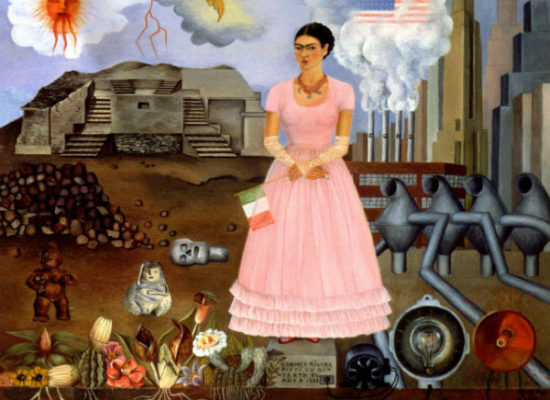
“The number of reverberations between then and now becomes horrible, and frightening, and amazing.” So said Detroit Institute of Arts curator Mark Rosenthal last week, at a preview of “Diego Rivera and Frida Kahlo in Detroit.” He’s right, possibly more so than even he knows.
During the Great Depression, the museum almost went under; the storm of publicity surrounding its commission of Diego Rivera’s epic Detroit Industry frescoes in 1932 saved it, inspiring the city to step in to fund DIA. Having just suffered another near-death experience amid Detroit’s recent bankruptcy, DIA is clearly hoping this show focusing on the art-history power couple’s year in Motor City can serve as a symbolic comeback. It will certainly bring crowds. (The show runs through July 12.)
Of course, by now it is Frida, not Diego, who is the main attraction (see Frida Fever: Iconic Photos of Frida Kahlo by Edward Weston and Others at Throckmorton). The Detroit Institute of Arts’s new crowd-pleaser is unlikely to change that gospel; her mordant self-examination just feels more contemporary than his grandiose political allegory.
And yet “Diego and Frida in Detroit” shows the Rivera/Kahlo pairing in a new light for me. There’s a story to be told—and since we are talking about parallels to the present, that should be told—about their art’s relative merits that is less about our changing tastes, and more about the tangled relationship of art and money, art and power.

Install view of the “Before” gallery of “Diego and Frida in Detroit,” with Frida Kahlo, Frieda and Diego Rivera (1931)
Photo: Courtesy Detroit Institute of Art
The show features work from “Before,” “After,” and “During” their sojourn in Detroit in 1932.
In the first category are examples of Rivera’s stately images of flower sellers, as well as Kahlo’s double wedding portrait of the two—he a giant, she tiny—painted while they were visiting San Francisco in 1931 (this picture represents the first time her self-conscious costuming makes an appearance in her art).
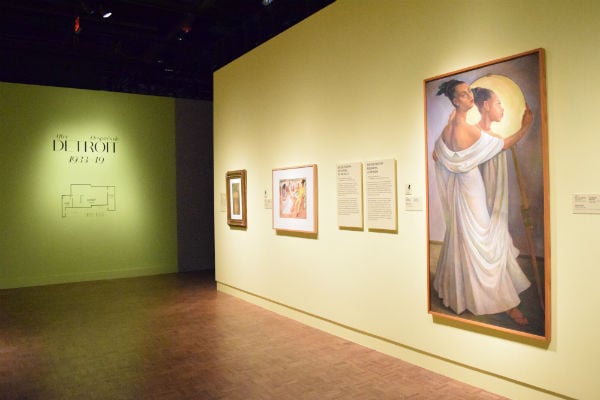
Installation view of “After” section of “Frida and Diego in Detroit,” with Diego Rivera, Portrait of Ruth Rivera (1949) in the foreground
Photo: Ben Davis
“After” features a focused but wide-ranging gathering of canvasses that give a sense of where they each wound up, aesthetically: Rivera’s stylish, willowy Portrait of Ruth Rivera (1949), his daughter from an earlier marriage; Kahlo’s gory true-crime painting A Few Small Nips (1935), showing a man having just butchered his wife.
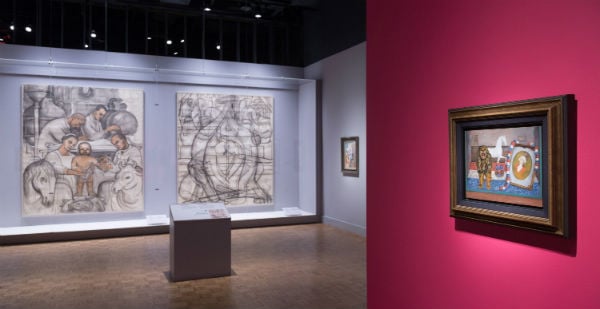
Install view of the “During” gallery at “Diego and Frida in Detroit”
Photo: Courtesy Detroit Institute of Art
But the heart of the show clearly resides in the galleries that chronicle the crucial year of 1932: the large-scale cartoons Rivera made to plan Detroit Industry, his meticulous 27-panel cycle depicting scenes from Ford’s River Rouge plant, which surround the DIA’s Rivera Court, and which are widely considered Rivera’s most important mural work in the United States. Also in these galleries are Kahlo’s series of canvasses and drawings showing her sharp turn towards Surrealism.
Detroit’s Agony
When they arrived in Detroit, the 44-year-old Rivera was one of the most celebrated artists in the world. As the key exponent of “Mexican Muralism,” he had built up a level of art fame that is now probably unthinkable. His retrospective at the young Museum of Modern Art was only the institution’s second devoted to a single figure. The first was Matisse.
His wife, 25, was a brash near-unknown. The two had ejected themselves from the Mexican Communist Party in 1929, but were still celebrity radicals, given to blustery anti-capitalist talk and mercurial symbolic gestures. The commission for Detroit Industry was $20,000 at the height of the Great Depression, more than $300,000 today. It would be paid for by Edsel Ford, the son of Henry and the chief of the Ford Motor Company, the era’s single most emblematic capitalist name.
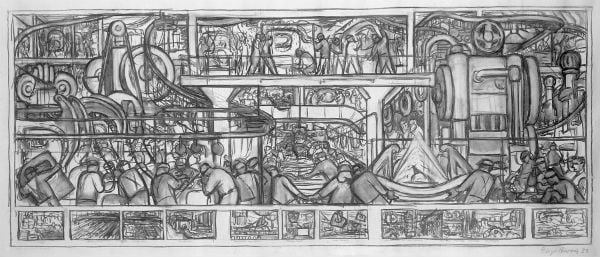
Diego Rivera, The Assembly of an Automobile (1932), a study for Detroit Industry
Photo: Courtesy Leeds Museum and Galleries
Detroit, meanwhile, was deep in the throes of the Depression, swollen with the homeless and unemployed. Ford’s River Rouge plant, which Rivera would depict with such muscular bravado in Detroit Industry, had laid off thousands of workers and was operating at reduced capacity. Pay had been slashed for the remaining workers—River Rouge paid more than $181 million in wages in 1929; two years later, just $76 million. Two months before the couple arrived, workers had marched on that very plant, demanding higher pay. Company security and police reacted with violence, killing six. The result came to be known as the “Ford Massacre.”
Rivera’s Compromise
As he had been everywhere he went on his US tour, Rivera was wined and dined in Detroit. He would remember that Henry Ford was a “true poet and artist” and that Edsel had the “simplicity and directness of a workman in his own factories.” Kahlo seems to have been less enthused, resorting to impotent needling of their hosts, asking Henry, a well-known anti-Semite responsible for injecting the Protocols of the Elders of Zion into the public mind, whether he himself was Jewish.
How did Rivera square the circle of his revolutionary beliefs and his arch-capitalist patron in his head? A book could be written about the combination of industrial romanticization (he claimed that during his visit to Russia in 1927-28, he had seen Ford’s image revered alongside Marx and Lenin) and artistic self-delusion (he believed that if he won the Yankee masses to his mural style, he had secured a public for revolutionary art) at play, but there is no doubt that it deeply compromised him, politically and artistically.
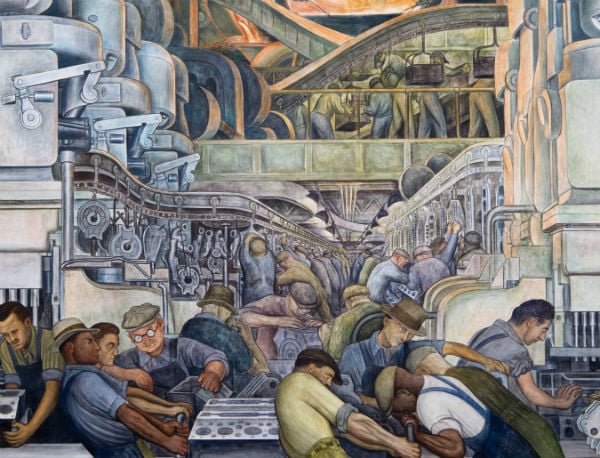
Diego Rivera, Detroit Industry north wall (detail) (1932) Photo: Courtesy Detroit Institute of Arts
Detroit Industry is a heroic and memorable depiction of factory labor, which is not nothing. It has passed deep into Detroit’s civic symbolism. But the striving enfilade of auto workers who form its central image are stolid, impassive—it is a picture of labor peace painted at a time of labor strife. They are also pointedly multiracial, when in fact the Fords kept their plants segregated.
Most importantly, it is, ultimately, a celebration of the boss: Edsel Ford, inserted in a panel at the corner in the manner of Renaissance paintings of patrons, gazes out benignly. It is a bravura work, but it is also an image that could serve in any PR pamphlet emphasizing Ford’s “progressive” corporate values—which is how it has often functioned.
![Diego Rivera, Detroit Industry south wall [detail] (1932-33), featuring Edsel Ford (in gray suit) and DIA director William Valentiner (in blue suit), depicted holding contract for the murals](https://news.artnet.com/app/news-upload/2015/03/Detroit-Industry-south-wall-detail-Edsel-Ford-and-Valentiner.jpg)
Diego Rivera, Detroit Industry south wall [detail] (1932-33), featuring Edsel Ford (in gray suit) and DIA director William Valentiner (in blue suit), depicted holding contract for the murals
Photo: Detroit Institute of Arts
As his final act in Detroit, Rivera wrote to Edsel Ford, asking him to rehire one W.J. Settler, a photographer with whom the artist had worked. In the words of Rosenthal’s catalogue essay, Settler “had been fired from his job with the Ford Company for smoking in his own home, thus violating one of the rules for employees.”
Edsel Ford did not rehire Settler. On some level, Rivera must have known that he had let himself be used.
Indeed, with some of this in mind, the most famous controversy of Rivera’s career—when, in the ensuing months of 1933, he inserted an image of Lenin (and what Rivera would describe as “a night-club scene of the debauched rich” featuring John D. Rockefeller, Sr.) into his Rockefeller Center mural commission in New York, provoking its destruction—appears to be a desperate grab at socialist credibility after a very public cop-out in Detroit.
Kahlo’s Breakthrough
In the lead up to Rivera commencing Detroit Industry, Kahlo became pregnant. On July 4, 1932, she lost the child. (The DIA show’s public text and audio indicate a miscarriage; the catalogue authors suggest that it was a self-induced abortion; I gather the truth is not known.) The emotion of this event, all the more focused as Kahlo felt stranded in a hostile city, knocked her art in a new direction, with lasting effects.
The painting that compresses all this is the compact, devastating Henry Ford Hospital. A bed floats in a barren plane. On it, Kahlo has painted herself, blood staining the sheets. Red threads branch from her abdomen connecting to various floating objects, hieroglyphic representations of trauma: an anatomical model; a crumpled orchid, inspired by the ones that Rivera had brought her in the hospital; a fractured pelvic bone; and so on.
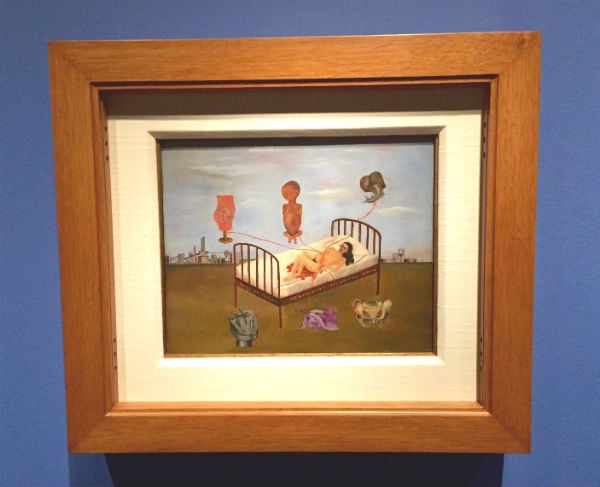
Frida Kahlo, Henry Ford Hospital (1932) Photo: Ben Davis
Rivera’s art was seemingly affected by the loss of the child as well, possibly accounting for the most idiosyncratic element of Detroit Industry. He had been planning a tableau of agricultural labor for the main East Panel. Now this section was taken over by an image of an unborn child, cradled in the bulb of a plant, a bit of personal mythology embedded in this very public statement.
![Diego Rivera, Detroit Industry east wall [detail] (1932)](https://news.artnet.com/app/news-upload/2015/03/detroit-industry-east-wall-fetus.jpg)
Diego Rivera, Detroit Industry east wall [detail] (1932)
Photo: Courtesy Detroit Institute of Arts
But most importantly to me is how Kahlo’s laceratingly personal Henry Ford Hospital can be read as a kind of rebuttal to Rivera’s mythologization of Detroit. On the side of the blood-soaked bed, Kahlo has stamped the title, “Henry Ford Hospital.” Yet she has placed herself not in the interior of the hospital, but outdoors, exposed in public; on the horizon in the background, Detroit’s industrial architecture is arrayed like a collection of castoff toys—the very structures that her husband was researching with a view to glorify. It is as if the painting were saying, “All is not right in the world of Henry Ford.”
![Details of Detroit Industry [left] and Henry Ford Hospital, comparing the depiction of the Detroit skyline](https://news.artnet.com/app/news-upload/2015/03/detroit-stylines-compared.jpg)
Details of Diego Rivera’s Detroit Industry [left] and Frida Kahlo’s Henry Ford Hospital, comparing the depiction of the Detroit skyline
Here, then, is an aesthetic hypothesis: If Kahlo’s work strikes us today as more alive, this is not only because social realism has gone out of vogue in favor of the intimate and the psychological. It’s almost the opposite, I think: Because Rivera became trapped in celebrating his host, he had to step back from the painful reality of the world he was depicting; Kahlo’s art, unencumbered by this burden and focusing on her own experience, actually does express some of that missing reality.
In this case, because Kahlo’s work is more personal, it is also more political.
Ford’s Gamble
There’s one final, long footnote on a part of the story of Diego and Frida in Detroit that doesn’t get told correctly.
Part of the legend of Rivera’s Detroit Industry, cementing its reputation as an enduringly subversive work, is the uproar surrounding its opening. Upon its unveiling in early 1933, conservatives protested the murals as atheistic, communist, dangerous. The debate in the press attracted hoards to the opening. There was even a bloc of workers who organized to defend Rivera’s opus.
Edsel Ford is given credit for having put a lid on the fracas by issuing a statement to those alarmed at the specter of the Mexican artist’s socialist politics that declared, “I admire Rivera’s spirit.” A key detail, however, is that this controversy was very possibly trumped up by Edsel Ford in the first place by planting incendiary stories in the papers. According to current DIA director Graham Beal, when Ford’s assistant showed him the attacks on the murals in the papers, the industrialist is said to have told him that “we’d accomplished what he wanted.”
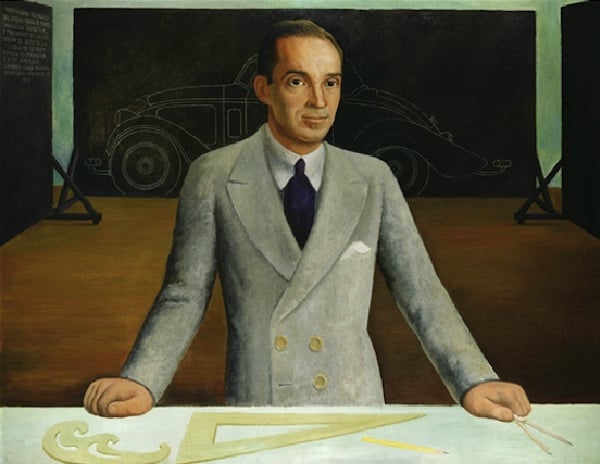
Diego Rivera, Portrait of Edsel Ford (1932), seen in “Diego and Frida in Detroit”
Photo: Ben Davis
Why? Ford had been personally bankrolling the museum through the Depression. The Rivera controversy attracted popular attention; the popular attention brought in big crowds; and the big crowds convinced the city to raise the museum’s budget, thereby taking a money-suck off his hands.
But there is another, much more important piece of context that doesn’t get nearly enough attention in telling the tale of Detroit Industry: the Detroit Banking Crisis of 1933, a disaster in which Edsel and Henry Ford played a very, very prominent role. To escape his father’s long shadow, Edsel had moved into banking in the 1920s, heading up the Guardian Trust Company. It expanded rapidly and unwisely, gobbling up smaller banks with real estate holdings that went dramatically sour after the stock market crash of 1929.
Throughout the entire period of the commission, creation, and unveiling of Detroit Industry, Edsel Ford would have been principally consumed with the intensifying crisis. He personally had to inject money into Guardian to backstop its escalating losses. Looking over its books, the national bank examiner would describe its operations as “the worst I’d ever seen.” In February, the government desperately tried to broker a rescue—but the deal would have involved Henry Ford freezing his massive deposits. Instead, the elder Ford threatened to remove them, ensuring disaster. “Let the crash come,” said the man Rivera remembered as a poet.
On February 14, 1933 after Ford refused the Feds’ rescue plan, all banks in the state of Michigan were shuttered. Five days later, on February 19, the first cartoons for Detroit Industry were shown at DIA.
This Lehmann Brothers moment—touching off a cascade of panic—was the immediate context of the unveiling of the work. Banks would not open again until March 24; and the Rivera Court, transformed with Rivera’s murals, debuted on March 21.
Perhaps the controversy that roared up around the DIA murals was fueled by their association with Edsel Ford. Indeed, the same right-wing radio preacher who attacked Rivera’s Vaccination panel as sacrilegious had been inveighing relentlessly against “banksters,” provoking alarming deposit withdrawals from his followers on Mondays after his sermons.
Yet one can also imagine that Edsel Ford might actually prefer, at such a moment, having a spotlight on his support of a left-wing artist’s depiction of labor instead of his role as figurehead of a failed company that was unleashing nationwide economic chaos.
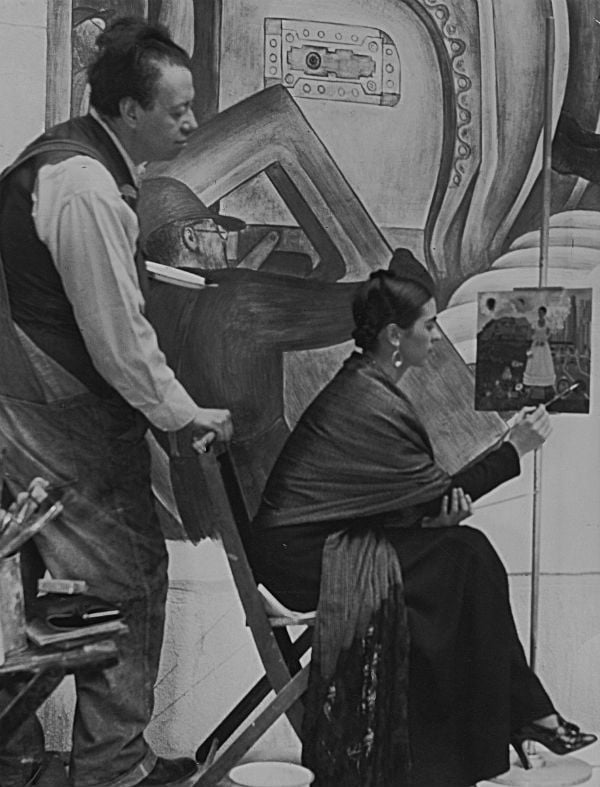
Diego Rivera and Frida Kahlo in Detroit (ca. 1933) Photo: Courtesy DIA Archives
Indeed, Ford’s support of Rivera continues to play that role to this day. Consider the catalogue for the present show, which contains an essay by John Dean titled, “‘He’s the Artist in the Family’: The Life, Times and Character of Edsel Ford,” extolling his “love of place, family, hard work, self-reliance, community, capitalism, and competition.” Dean argues that Edsel Ford’s partnership with Rivera makes him an example of the “businessman as artist.” He does not mention his role in one of the most catastrophic incidents of the Great Depression, despite its proximity to the Rivera event.
A little radical art patronage, it seems, buys you a lot of good PR, and for eternity. But it would be a shame to let the allure of art celebrity occlude what should be the larger moral of this show’s story, one that seems very relevant for the present indeed: Ford giveth, and Ford taketh away.
“Diego Rivera and Frida Kahlo in Detroit” is on view at the Detroit Institute of Arts through July 12, 2015.